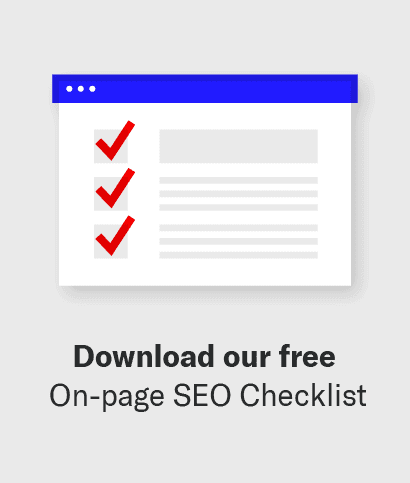Tired of creating content that doesn’t rank or convert? The problem may result from a simple — and easily avoidable — issue with the post’s SEO.
Considering that over 67% of all clicks go to the top five organic results from a search engine, high rankings are crucial for content to convert your readers successfully.
Even if you implement a solid content strategy, common SEO mistakes (like lengthy title tags or unoptimized URL slugs) may be what ultimately prevent your content from reaching new heights on the SERP.
Here at Siege Media, it’s no surprise when a client begins ranking #1 in six months. Regarding search engine optimization issues, we’ve seen it all and offer industry-tested solutions that generate lasting results. We’ve worked with hundreds of clients, and here are the most common SEO mistakes we see when they first arrive:
- Duplicate Content
- Keyword Stuffing
- Lack of Mobile Optimization
- Slow Site Speed
- Lengthy Title Tags
- Missed Linking Opportunities
- Generic Anchor Text
- Lack of Local SEO
- Forgetting To Add Alt Text
- Unoptimized URL Slug
1. Duplicate Content

Publishing similar or identical content that aims to satisfy the same user intent can confuse search engines like Google and ultimately dilute the visibility of your page. Duplicate content is especially hazardous if the original content stems from outside your organization. An algorithm may prefer the page that was published first, updated recently, or best satisfies E-E-A-T protocols.
How to fix it:
Use canonical tags to specify the original version of the content, consolidate similar content into one page, and ensure each page offers unique value to your audience.
SEO tip: If you have an e-commerce site with product descriptions pulled from the manufacturers, rewrite them to be original and consider adding value to them with useful information, like customer reviews or testimonials.
2. Keyword Stuffing

Unnatural keyword placements don’t go unnoticed by search engines either. The algorithm may view awkward keyword usage as an attempt to manipulate search engine rankings and penalize you accordingly. Readers may also catch on to the inorganic rhetoric, resulting in less time exploring your site or going down the funnel.
How to fix it:
Conduct thorough keyword research to discover long-tail keywords adjacent to the principal term your page is attempting to rank for. Select a handful of the most relevant long-tails, keeping attributes like search volume and keyword difficulty top of mind, and sprinkle them into the copy no more than two or three times each.
SEO tip: When writing a blog post, place your target keyword in the title, intro, and conclusion, and only put it where it sounds most natural in the rest of the copy.
3. Lack of Mobile Optimization

One of the biggest SEO mistakes is forgetting that users often consume your content on their mobile devices. To maintain a top-notch user experience, it’s more important than ever that your content is easily accessible in any format. Although it may take more elbow grease to create a seamless transition from desktop to mobile, your rankings will thank you for it.
How to fix it:
Follow blog design best practices by integrating responsive web design into your blog’s layout. This approach can reduce the time it takes to manually adjust your site to the specifications of mobile devices like tablets and smartphones. A seasoned agency with premium web design services can also assist you.
SEO tip: Create mobile-friendly versions of interactive content and design assets so they read well on smaller screens and are equally enjoyable in portrait mode.
4. Slow Site Speed

Consider the frustration you feel while waiting for a page to load. Now, imagine a potential customer feeling the same way about your slow site speed. When your website takes too long to load, users are more likely to abandon the page, resulting in higher bounce rates and decreased conversions.
How to fix it:
Consider what could be contributing to the slow loading time of your website. Potential solutions include mitigating CSS and JavaScript files, enabling browser caching, and switching website hosts. If you’re struggling to identify the root cause of SEO errors like this, set up a technical SEO consultation to pinpoint the issue.
SEO tip: If your blog page includes too many visual elements, compress large image files to reduce their size and improve page loading times.
5. Lengthy Title Tags

Learning how to write a concise title tag is both an art and a science. Title tags that are too long can get cut off in search results, diminishing their effectiveness in conveying your content’s relevance to the user. It’s also a good idea to include your business’s or website’s name in the title tag to boost brand awareness.
How to fix it:
Keep title tags brief (around 50-60 characters) while accurately describing the content and incorporating relevant keywords. Decide if your tags will be in title case or sentence case and remain consistent with the formatting.
SEO tip: Instead of “Best Running Shoes for Marathon Training – Top Picks for Serious Runners,” include your brand name and shorten it to “Top Picks: Best Marathon Running Shoes.”
6. Missed Linking Opportunities

Another one of the most common SEO problems is not including a comprehensive, organic link building strategy. Internally linking signals to Google that you post important pages on the site and can help it rank more quickly.
Neglecting to link internally and externally can limit search engine crawlers’ ability to discover and index your content, reducing your website’s overall authority.
How to fix it:
Include relevant internal links to other pages on your website and external links to reputable sources when appropriate. Hiring skilled link builders is a fool-proof way to expand your backlink profile. Promoting passive link building is also possible by prioritizing shareability strategies during the content creation phase.
SEO tip: In a blog post about fintech app trends, internally link to articles discussing finance, technology, and recent innovations in app development.
7. Generic Anchor Text

Don’t let SEO issues like boring anchor text keep you from ranking. Using generic anchor text like “click here” or “read more” instead of descriptive, keyword-rich anchor text that generates organic links can diminish the SEO value of the link.
How to fix it:
Consider the intent behind the page you’re linking to and allow that to determine the anchor text. Use descriptive text that provides a deeper understanding of the article’s theme and, if possible, includes relevant keywords.
SEO tip: Instead of plain anchor text like “website tips,” try something more descriptive like “actionable SEO tips.”
8. Lack of Local SEO

If you’re executing SEO campaigns for startups or small businesses, it’s imperative that you take advantage of the benefits of localized SEO services to improve brand recognition and visibility within the community you serve. Skipping this step means that your target audience may not know who you are, how you can solve their problem, or where they can access your services.
How to fix it:
Include location-specific keywords in page titles, meta descriptions, and content to target local search queries. Encourage customer reviews and add your brand’s name to appropriate directories like Google Maps.
SEO tip: Instead of citing your business as “a good bed and breakfast” on your website, try “Atlanta’s Best B&B” and mention your proximity to the local botanical garden and airport.
9. Forgetting To Add Alt Text

One of the most common SEO mistakes to avoid is forgetting to add alt text to images on your page. Not only can search engines crawl alt text, but it also serves as a means to increase the accessibility of your content for users who require text-to-speech service to navigate the web.
How to fix it:
Provide descriptive alt text for images that accurately describes their content and includes long-tail keywords where appropriate. A great way to ensure that alt text is always top of mind is to partner with an agency that prioritizes the experience of all users in your content strategy.
SEO tip: For an image of a red bicycle, use alt text such as “A person rides a red bicycle on a sunny day riding along a country road.”
10. Unoptimized URL Slug

The last of the most common technical SEO issues is hiding in plain sight. A URL slug is the last part of a URL and serves as the address for a specific page. Using lengthy, unclear, or non-descriptive slugs can confuse users and search engines — making it harder to understand the content’s relevance when determining ranks.
How to fix it:
Create concise yet descriptive slugs. Ideally, your URL slug will be the same as your target keyword so the search engine can quickly tell what the page is trying to rank for.
SEO tip: Instead of a URL like “website.com/p=123,” try “website.com/blog/seo/seo-best-practices” for a page about SEO tips.
Upgrade Your SEO Strategy
Content markets live and breathe SEO. Let us flex our strategy muscles and do the heavy lifting that keyword research, technical SEO audits, and user experience analysis require.
If you’re ready to upgrade your content strategy and avoid common SEO mistakes, take a peek at our ROI-driven success stories for insight on how we can help.





